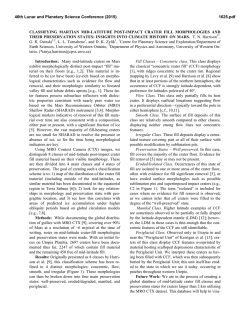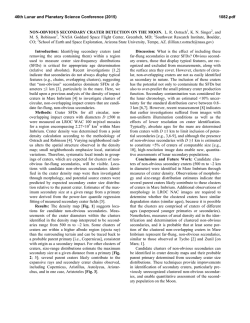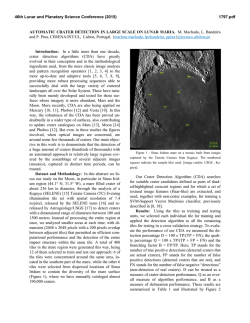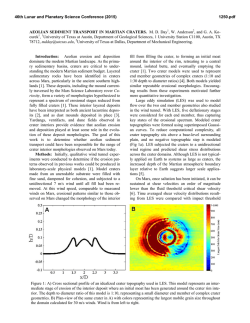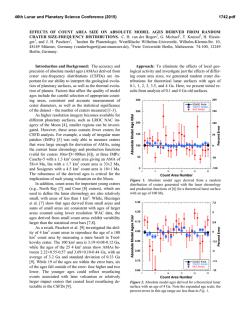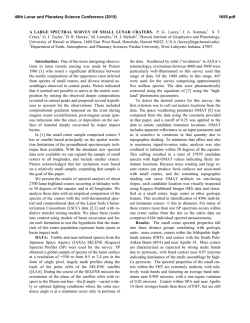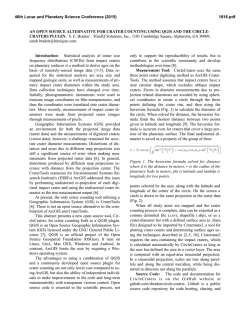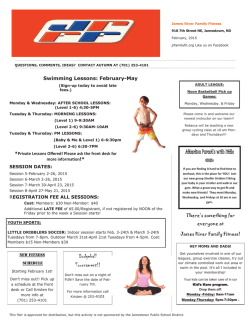
Secondary Craters Associated with the Rayed Crater Zumba
46th Lunar and Planetary Science Conference (2015) 2488.pdf SECONDARY CRATERS ASSOCIATED WITH THE RAYED CRATER ZUMBA, DAEDALIA PLANUM, MARS. F. C. Chuang1, D. A. Crown1, and L. L. Tornabene2, 1 Planetary Science Institute, 1700 E. Ft. Lowell Road, Suite 106, Tucson, AZ 85719 USA; 2 Centre for Planetary Science and Exploration, Dept. of Earth Sciences, Western University, London, ON N6A 5B7, Canada ([email protected]). Introduction: Zumba is a 2.9 km diameter impact crater located in Daedalia Planum (center: 28.6° N, 226.9° E), an area of elevated plains at the southern margin of the Tharsis region. The Daedalia Planum area is dominated by expansive lava flow fields and also includes embayed and isolated massifs of ancient highland materials, degraded impact crater rims, and areas of rugged terrain [1-8]. The Zumba impact event occurred on the lava flows, which from previous geologic mapping were identified as part of the Hesperian-age Tharsis Montes formation [1]. One of most distinctive features of Zumba is the prominent rayed pattern emanating from the impact site. In Thermal Emission Imaging System (THEMIS) infrared data, the rays are highly distinct, with some reaching hundreds of kilometers in length [9]. For Zumba and several other rayed craters on Mars [9,10], the rays correlate well with dense clusters of secondaries that are best observed in Mars Orbiter Camera (MOC), Context Camera (CTX), and High Resolution Imaging Science Experiment (HiRISE) images [9-12]. This correlation is in contrast to other craters on Mars with ray-like patterns in thermal data (e.g., Hale and Mojave [13,14]), but that lack dense clusters of secondaries. Instead, these patterns represent either ejecta rays or air-blasted surfaces. We refer to the rays in this study as secondary crater rays. We have recently completed detailed mapping of Zumba secondary craters to investigate their distribution and density as a function of distance from the impact site. Given the young age (potentially 100 ka) [15], good state of preservation, and relatively uniform geology of the impact region, this information provides insight into the cratering process (e.g., direction and angle of impactor), a means to assess ages derived from small crater populations [15,16] and the spallation process on a body with an atmosphere [17], and to gauge the volcanic compositions and stratigraphy at the impact site and where secondary craters formed (see [3]). Previous studies of Martian rayed craters suggest that the Zumba impact site may have a provided a source for Martian SNC meteorites [3,9]. Data, Methods, and Study Region: Global 100 m/pixel THEMIS daytime and nighttime IR mosaics were used as the primary base in studying the regional geologic features of Daedalia Planum and crater Zumba. The mapping area consists of the entire region within a 200 km radius of Zumba. Secondary crater rays, a few of which extend further than 200 km, were first mapped using THEMIS data. After detailed examination of the rays and other areas within the study region, secondaries were mapped on 5-6 m/pixel CTX images (49 total), which covered 72% of the mapping area. Secondary craters are most often observed in groups within dark areas of the surface, presumably due to removal of bright dust by impact processes. In this study, only solitary and dense groups of secondary craters (hereafter termed secondary fields) with associated dark deposits were mapped and stored as polygon features using ArcGIS 10.2.2 software. Mapping Results: A total of 12,793 secondary fields were mapped, covering a cumulative area of 2459.2 km2. Statistics for the population of secondary fields are provided in Figure 1. The vast majority of secondary fields (n=12,310; 96.2%) are small (0.005-1 km2). We find that small to medium-sized secondary fields are widespread throughout the 200 km radial area whereas larger secondary fields (10-50 km2) are associated with and concentrated within the large secondary crater rays. In order to analyze the distribution of Zumba secondaries, we divide the mapping area into eight primary 45° sectors (Figure 2). Within each of these sectors, we also divide the distance into 50 km increments from the center of Zumba out to 200 km, for a total of 32 individual sectors. Sectors with coverage gaps occur within 100-200 km from Zumba. For the entire study region, the percentage of area covered by secondary fields in any given sector ranges from ~0.095% to 19.4%. We find that the highest areal coverages occur within 100 km of Zumba (a1-h1 & a2h2) and that beyond this, sectors c3-4, f2-3, and g2-4 exhibit the highest areal coverages due to the longest secondary crater rays located in these areas. If we consider each 50 km "ring" of sectors (8 sectors in each ring, A-D in Fig. 2) around Zumba, the peak cumulative number and greatest areal coverage of secondaries occurs in ring B (Table 1). These values decrease in rings C and D. Overall, the data show that from A to D, the average mean size of secondary fields decreases, which is consistent with the expectation of lower numbers and smaller sizes of secondary craters with greater distance from the impact site. For rings A and B, the average mean sizes are much larger (minimally ~3.6X) than for rings C and D. This is consistent with our earlier result 46th Lunar and Planetary Science Conference (2015) that most secondaries are located within 100 km of the impact site. We have also made preliminary estimates of the crater density for mean-sized secondary fields (0.193 km2) in the study area. Of the nine secondary fields selected (within ±500 m2 of the mean), we count 5-18 craters for a density of ~25.9-93.3/km2. Assuming that this density is solely due to the Zumba impact, ~63,693-229,443 secondary craters were produced. These values are ~1-3 orders smaller than estimates of secondary craters for the 10 km diameter rayed crater Zunil [10,11]. However, Zunil's population may be an overestimate due to the overlap of secondary craters produced by crater Corinto [18]. References: [1] Scott and Tanaka (1986) USGS Misc. Invest. Ser. Map I-1802-A. [2] Dohm et al. (2001) USGS Misc. Invest. Ser. Map I-2650. [3] Lang et al. (2009) JVGR, 185, doi:10.1016/j.jvolgeores.2008.12.014. [4] Scott (1981) USGS Misc. Invest. Ser. Map I-1274. [5] Scott and Tanaka (1981) USGS Misc. Invest. Ser. Map I-1281. [6] Crown et al. (2011) LPSC 42, Abstract #2353. [7] Crown et al. (2013) LPSC 44, Abstract #2499. [8] Bleacher et al. (2007) JGR, 112, doi:10.1029/2006JE002873. [9] Tornabene et al. (2006) JGR, 111, doi:10.1029/2005JE002600. [10] McEwen et al. (2005) Icarus, 176, 351-381. [11] Preblich et al. (2007) JGR, 112, doi:10.0129/2006JE002817. [12] Calef et al. (2009) JGR, 114, doi:10.1029/2008JE003283. [13] Williams and Malin (2008) Icarus, 198, doi: 10.1016/j.icarus.2008.07.013. [14] Jones et al. (2011) Icarus, 211, doi:10.1016/j.icarus.2010.10.014. [15] Hartmann et al. (2010) Icarus, 208, doi:10.1016/j.icarus.2010.03.030. [16] Hartmann (2007) Icarus, 189, doi:10.1016/j.icarus.2007.02.011. [17] Melosh (2001) Impact Cratering, 245 pp. [18] Golombek et al. (2014) LPSC 45, Abstract #1470. 2488.pdf Table 1. Statistics for areal coverage by Zumba secondary fields in sector rings A-D*. Ring count min max med mean±stdev (n) (km2) (km2) (km2) (km2) A 354 0.0030 6.38 0.133 0.336±0.635 B 490 0.0015 11.1 0.065 0.284±0.800 C 383 0.0037 2.81 0.026 0.077±0.222 D 386 0.0017 2.85 0.023 0.049±0.155 * see fig. 2 for defined sector rings Figure 1. Histogram of areal coverage of Zumba secondary fields showing high positive skew (~18). Approximately 96% of secondary fields are 0.005-1 km2 in size. Figure 2. Azimuthal distribution of mapped Zumba secondary fields (black polygons). Hotcool colors represent the percent area covered by secondaries in each sector (45° circumferential arc and 50 km wide from the crater center, 32 total). Highest densities are within 100 km of Zumba and in sectors containing the longest rays (c3-4, f2-3, g2-4). Statistics for each 50 km "ring" of eight sectors (A-D) are shown in Table 1. Background composed of THEMIS day IR base mosaic with overlying CTX images.
© Copyright 2025
